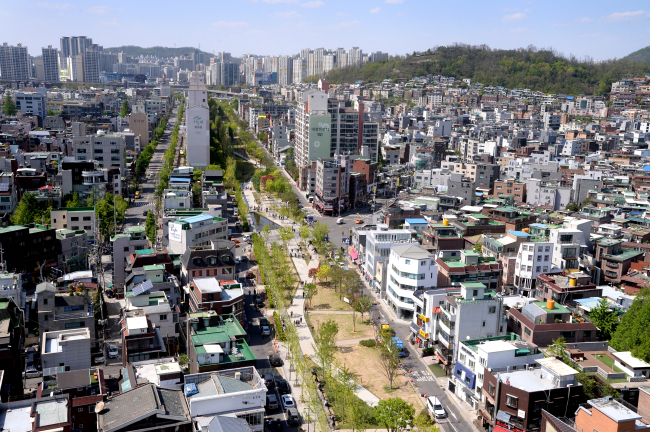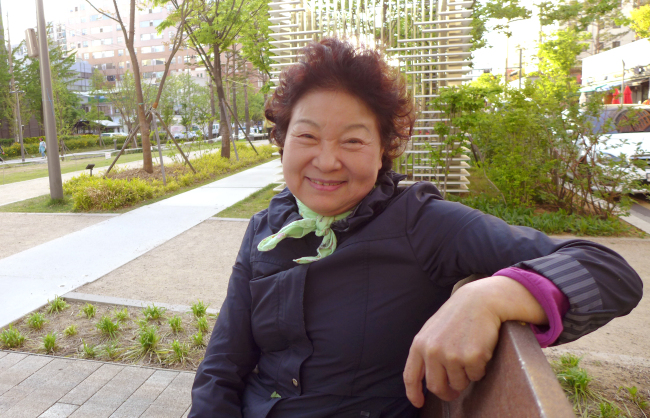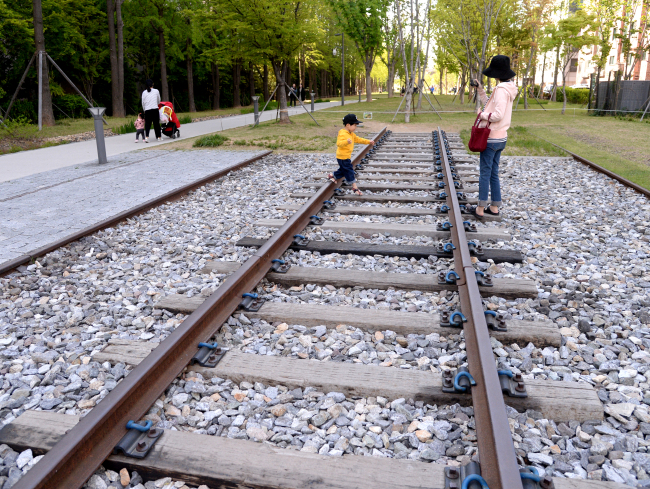[Seoul Saunter] Repurposed park acts as corridor of civic energy
Seoul is a vibrant megalopolis with modern high-rises crowding the city’s major arteries. Nestled among the gleaming buildings are maze-like alleys that appear to have escaped the passage of time. The Korea Herald explores its many nooks and crannies.
By Korea HeraldPublished : May 1, 2017 - 17:47
Around sunset each day, Park Bong-soon strolls through the Gyeongui Line Forest Park, back and forth, for a good healthy hour.
For the 71-year-old resident of the area near Gongdeok Station in northwestern Seoul, the refashioned esplanade stretching from Hyochang Park Station to Gajwa Station is an urban oasis of recreation and leisure.
“I come here every day because it’s safe and comfortable to saunter,” Park told The Korea Herald. “The scenes of families, children and young people enjoying their leisurely time seem so lovely.”
Park, who has lived in the area for over 45 years, said the neighborhood was a run-down shantytown when she first moved in. Since the early 2000s, however, a series of high-rise apartment and commercial buildings started filling the district, bringing sea changes to homes and businesses.
For the 71-year-old resident of the area near Gongdeok Station in northwestern Seoul, the refashioned esplanade stretching from Hyochang Park Station to Gajwa Station is an urban oasis of recreation and leisure.
“I come here every day because it’s safe and comfortable to saunter,” Park told The Korea Herald. “The scenes of families, children and young people enjoying their leisurely time seem so lovely.”
Park, who has lived in the area for over 45 years, said the neighborhood was a run-down shantytown when she first moved in. Since the early 2000s, however, a series of high-rise apartment and commercial buildings started filling the district, bringing sea changes to homes and businesses.

The long stretch of land on top of the underground Gyeongui railway and Airport Railroad has been going through a process of redevelopment into a green passageway since 2009, materializing from an agreement between the Seoul Metropolitan Government and Korea Rail Network Authority.
The pathway has been spruced up with festoons of flowers, trees, greens, ponds, sculptures and benches. Bookstores, railroads, bikeways and walkways along the path provide extra amenities to the public. Adjacent to the platform, rows of restaurants, cafes, bars and stores have opened in recent years.
“Old folks like me want to live in the countryside, but our basic needs are more easily met in the city,” the lady with an innocuous smile commented. “We also get easily sick, therefore need hospitals and emergency services close to our homes. By living next to our children, we can baby-sit the grandchildren. I think having more of these green spaces is preferable to high-rise buildings for everyone.”

Park Yoon-suh, a university student and nearby resident, said she frequents the park on her way to and from school. She often walks her dog there, and rides her bicycle on the accompanying bike lane.
“It’s safer than roads to walk, and also feels refreshing,” Park said. “It used to be difficult for dog owners to walk their pets before the passage was renovated, but now I see more people jogging with their dogs, and new dogs cuddling each other upon encounter.”
Noting that Seoul doesn’t have enough public parks, Park said that creating more of them would encourage citizens to spend less time at shopping malls and coffee shops, and more hours exercising outdoors.

“The urban planning paradigm of yesteryear was about filling up empty spaces, but it has now changed to emptying wherever is clogged, to give the city more breathing room,” said professor Choi Mack-joong of Seoul National University’s Graduate School of Environmental Studies in an interview.
“Moreover, the Gyeongui Line Forest has incorporated many successful planning lessons from parks around the world, including those in Boston, New York City, San Antonio in Texas, Birmingham in England and Nice in France.”
Linear spaces like the Gyeongui park allow more contact areas for diverse functions, the scholar expounded, adding they are increasingly valued as cities become wealthier, greener and more sustainable. Despite the possibility of adjacent properties becoming more expensive through gentrification, Choi said green amenities are still in short supply compared to leading global cities with high livability rankings.
“What’s also important is managing these public goods,” he stressed, adding drunken brouhahas should be curbed for civic peace and quiet.
By Joel Lee (joel@heraldcorp.com)
-
Articles by Korea Herald


















![[KH Explains] Hyundai's full hybrid edge to pay off amid slow transition to pure EVs](http://res.heraldm.com/phpwas/restmb_idxmake.php?idx=652&simg=/content/image/2024/04/18/20240418050645_0.jpg&u=20240418181020)

![[Today’s K-pop] Zico drops snippet of collaboration with Jennie](http://res.heraldm.com/phpwas/restmb_idxmake.php?idx=642&simg=/content/image/2024/04/18/20240418050702_0.jpg&u=)